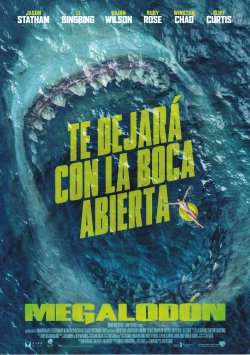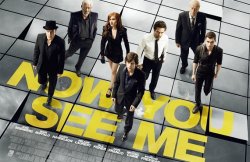 |
|
SINOPSIS
Cinco años atrás el capitán de la Marina Jonas Taylor mientras exploraba la Fosa de las Marianas se encontró un peligro desconocido lo que hizo que tuviera que abortar la misión y dejase a la mitad de la tripulación. El incidente acabó con su carrera, su matrimonio y todo tipo de honores que había cosechado en su carrera. El peligro fue que una criatura cuya especie se extinguió hace más de un millón de años, fue la causante de todo...
INTÉRPRETES
JASON STATHAM, RUBY ROSE, RAINN WILSON, ROBERT TAYLOR, BINGBING LI, JESSICA McNAMEE, CLIFF CURTIS, ÓLAFUR DARRI ÓLAFSSON, MASI OKA, PAGE KENNEDY, ANDREW GRAINGER, GLEN LEVY, WINSTON CHAO, TIM WONG
MÁS INFORMACIÓN DE INTERÉS
![]() CLIPS
CLIPS
![]() VIDEO ENTREVISTAS
VIDEO ENTREVISTAS
![]() AUDIOS
AUDIOS
![]() PREMIERE
PREMIERE
![]() SECUELAS:
SECUELAS:
Megalodón 2: La fosa (2023)
MÁS DATOS...
 INFORMACIÓN EXCLUSIVA
INFORMACIÓN EXCLUSIVA
The depths of the ocean. Unexplored. Unknown. Unconquered.
“The Meg” is an exhilarating adventure that director Jon Turteltaub says “takes you into a world you have imagined but have never seen. And that is exactly what’s fun and exciting about movies.”
Global action star Jason Statham, who leads an international cast in the sci-fi thriller, adds, “I think this is the ultimate popcorn film. It gives you what people go to the cinema for: entertainment, suspense, action, and even a few laughs—all of the things audiences want from a big moviegoing experience.”
“The Meg” is short for Megalodon, an enormous shark believed to have been extinct for more than two million years. “We love the prehistoric world and the mysteries it holds,” Turteltaub remarks. “But what if we discovered that this ancient animal was alive today? If this gigantic beast was suddenly unleashed and roaming the oceans, nothing would be safe in the water—not whales, not sharks, not humans. And how much would our entire ecosystem be thrown off balance?”
“I have always had a fascination with the underwater world and have been scuba diving for almost 20 years,” says Statham. “The oceans are so vast, and, rationally, I think most people have a fear of what’s down there and automatically assume the worst, especially about sharks. Sharks are one thing that take no prisoners. A great white would put the fear of God into any swimmer, so you can only imagine what something three or four times that size would do to you. You wouldn’t want that chasing you down.”
In the film, Statham plays Jonas Taylor, an undersea rescue diver who was the best of the best before a terrifying brush with a massive creature powerful enough to crush the hull of a nuclear submarine. The traumatic attack took the lives of two friends and put Jonas into voluntary drydock: for five years, he has given up diving for drinking…until fate forces his hand. The emergence of a Megalodon at the bottom of the Pacific Ocean is threatening the lives of a crew from Mana One, an oceanic research institute off the coast of China. Jonas could be their last and only hope.
Turteltaub offers, “Jonas is the only one with the experience and expertise to rescue them, but he’s given up on life. They bring him back in, very reluctantly, but they find out they are facing more than they bargained for.”
“The Meg” is based on the best-selling novel MEG by Steve Alten, which first caught the attention of producer Belle Avery.
Avery recalls, “I read the book and immediately saw the potential for an action-filled adventure with global appeal because sharks are such a popular thing in our culture. This story deals with a creature we’ve never seen before, but, then again, so much of our oceans remains to be discovered. Can you absolutely say with certainty that Megalodons don’t exist? I don’t know if you can,” she smiles.
The global nature of the story also presented Avery with an opportunity to expand on her work in the flourishing Chinese film industry. “I had already been consulting for years in China,” she explains, “but my biggest priority was making sure we had the right partner for this project. When I met Jiang Wei at Gravity Pictures and showed him the seven-inch Meg tooth, he immediately got it. He knew we could make this an organic, synergistic coproduction, which is the only thing I was interested in doing, and the only thing Gravity was interested in doing.
“Setting the research center in the Pacific and bringing in the characters of Dr. Zhang and his daughter, Suyin, to head it, was a hugely important element,” Avery continues. “And one of the largest dive centers in the world is in Tianjin, so it made perfect sense narratively.”
Producer Lorenzo di Bonaventura adds, “Our partners at Gravity Pictures were fantastic collaborators. That was invaluable since we were not only working with them on the production side but would also be shooting a portion of ‘The Meg’ in China. It was a true joint effort.”
One of China’s most popular leading ladies, Li Bingbing, who stars as Suyin, states, “Film is one of the best ways to breach the gap of two different cultures. There is great value in Eastern and Western audiences having a better understanding of each other, so this kind of cooperation is a win-win for everyone.”
Screenwriters Dean Georgaris and brothers Jon and Erich Hoeber teamed up to adapt Alten’s book for the screen. Jon Hoeber details, “We’d previously been working on our own drafts of the script, but then Lorenzo suggested we write together, combining the best aspects of each, which is exactly what we did.”
Georgaris, who had originally received the novel from Avery, says, “As a writer, any time you are dealing with a primal fear or fascination, including sharks, monsters, or, as in this case, both, you get the chance to do two things in combination: you get to create some jolts and thrills, and you also get to infuse some moments of comic relief. One of the things Jon, Erich and I wanted to do was to take the thrills seriously, but also let our characters—and hopefully the audience—have a little fun, too. After all, it’s a 75-foot Megalodon; you want to see it destroy as many things as possible.”
“We all know the giant shark is going to eat a bunch of people,” adds Erich Hoeber. “We’re waiting for it. But even though the stakes are life and death, we definitely tried to give the audience a little wink here and there along the way on this wild ride.”
Producer Colin Wilson says, “Dean, Jon and Erich took the original source material that Steve Alten created, which was rich with ideas, and wrote a screenplay that captured just the right balance of suspense, action, humor and diverse characters. And in Jon Turteltaub’s hands, it was like lightning in a bottle. He was the perfect director for this film.”
When Turteltaub was sent the script, he says a major draw for him was the fact that “it was new territory for me. I had never done a big monster movie—certainly not a giant shark movie—so I thought, ‘Okay, this is going to be a challenge…so let’s do it!’”
In tackling the project, Turteltaub notes, “We were aware that Steve Alten’s book—actually the whole book series—has a big following, and while there are always changes that have to be made in adapting a book into a film, we wanted to make sure those fans, and movie fans, got what they wanted.”
Avery says, “Jon was able to juggle all the demands of filming on and in the water and dealing with a lot of complex visual effects, while still giving every actor the individual attention they needed. That’s something he does brilliantly. It was amazing watching him work with the cast, especially given that there was a bit of a language barrier for a few of them.”
Bingbing attests, “One thing Jon would do that I appreciated: just before he said ‘Action,’ he would throw me a new line. He never worried that English is not my first language. He’d say, ‘You can do it, Bingbing, no problem.’ Jon trusted me, and I trusted him. He is very creative and smart and so nice; he treated everyone on the set with respect. He is an amazing director and I loved working with him so much.”
Fellow cast member Rainn Wilson comments, “Jon’s knowledge of how to direct an action movie goes without saying, but he also has a tremendous sense of humor, which kept things really light on the set and fostered a more creative environment.”
Joining Statham, Li and Wilson in the ensemble cast are Cliff Curtis, Winston Chao, Sophia Cai, Ruby Rose, Page Kennedy, Robert Taylor, Ólafur Darri Ólafsson, Jessica McNamee and Masi Oka.
“We had a terrific cast,” says Turteltaub. “They all brought so much added dimension to their roles. And that was vital because you’ve got to be invested in the characters. If you don’t care about the characters, you won’t care who gets eaten by the Meg,” he grins.
Of course, one central character was never actually on set. The Meg and all of the other aquatic life seen in the film were brought to life via state-of-the-art CGI, overseen by visual effects supervisor Adrian De Wet.
Turteltaub’s behind-the-scenes creative team also included cinematographer Tom Stern, production designer Grant Major, editors Steven Kemper and Kelly Matsumoto, costume designer Amanda Neale and composer Harry Gregson-Williams.
Filming on “The Meg” was accomplished entirely on location in New Zealand and China and in the waters off the coasts of both countries.
RESURRECTING THE MEG...
The creation of the title character in “The Meg” began with extensive research. Turteltaub notes, “One thing I love about my job is that on every movie I become a pseudo-expert on something. I began doing research into Megalodons and sharks because the more you draw people in with what is true, the more frightening things are.”
The skeleton of a Megalodon—just as in sharks today—was formed of cartilage rather than bone, so very little remains of them except teeth and some fossil vertebrae. VFX supervisor Adrian de Wet offers, “There is a formula to extrapolate the size of the creature based on the teeth, but there are different theories about what they actually looked like when they swam the oceans. We started by looking at what scientists, archeologists and paleontologists speculate about them and took that as our starting point. But we had some fun coming up with our Meg design and went through a number of iterations before we arrived at the final look. We tried to make it appear massive and terrifying and awesome, but at the same time very graceful in the water. Most importantly, the Meg is not just a larger version of a great white.”
Apart from the obvious size disparity, some of the notable differences between the Meg and today’s sharks were in the skin and in the number of gills. Turteltaub clarifies, “We gave our Meg more gills than a shark would have because we conjectured that in the oxygen-poor environment at the bottom of the ocean, it might have evolved extra gills.”
For the skin, de Wet describes, “We went for an uneven brown coloration with a gnarly texture. It has been in a few battles with other animals, so we added a lot of scratches and scars and the dorsal fin has nicks and tears in it. There are even barnacles that have attached themselves to the Meg over the years.”
The Meg’s most fearsome feature, by far, is its bite. “Its mouth is huge and there are hundreds of teeth,” de Wet says. “They are arranged in rows, are razor sharp and serrated for tearing flesh. Once its prey goes into the Meg’s mouth, it’s not getting out.”
As they finalized the Meg’s appearance, de Wet collaborated with the VFX houses Scanline, Double Negative and Sony Imageworks to breathe life into the character. “The Meg is enormous, but it has also spent millions of years evolving into a hydrodynamic killing machine, so it’s very agile and fast,” de Wet comments. “It has quite a flexible body and with a big swish of its tail, it can get up to speeds approaching that of a small speedboat. We studied the biomechanics of sharks quite closely and did computer tests of swim cycles and how the Meg would achieve forward motion. It took a great deal of R&D to get the muscles to look correct under the skin as the Meg moves.”
For specific sequences, physical models of the Meg’s head and tail were also constructed. However, since the actors would generally be using their imaginations, the filmmakers came up with a clever visual reference to help them picture the beast’s size in its entirety. Di Bonaventura recalls, “We lined up shipping crates between 70 and 90 feet in length, and then drew the Meg on the side of the containers. When you can actually see the size, it’s overwhelming. You realize we’re like sardines in comparison. It would take a lot of us to make a satisfying meal,” he grins.
In addition to the Meg, the VFX teams were also responsible for generating the entire undersea world of the film, including the topology of the ocean floor and the spectrum of strange beings discovered below the thermocline. “We began with actual extant species and then took a little poetic license,” de Wet allows. “Some of them are hybridizations of other species that we blended together because the idea there is it’s a piece of the Earth that’s been cut off and never seen before.”
With water being the Meg’s natural habitat, water effects naturally followed. “If you’ve got an enormous creature breaching through the water, there is a great amount of spray and particulate being thrown everywhere, which mostly had to be rendered in CG,” de Wet confirms. “Fortunately for us, we had some of the best people in the world who are renowned for doing water effects.”
“I was knocked out by the visual effects,” says Turteltaub. “It’s not just moving pixels around the screen—they create drama and story in a multidimensional way that makes the audience stop thinking of these creatures as animated at all. It’s brilliant, what they do.”
JUST KEEP SWIMMING...
Virtually all of the story unfolds in or on the water, so it was a matter of necessity and, more vitally, safety that the entire cast know how to swim well.
Dive coordinator David Murrell says, “Whenever any actor was going to be in the water, our dive teams and safety swimmers were with them at all times. At the same time, we had to make sure the actors themselves were strong enough and secure enough in the water to do what was going to be asked of them.”
Stunt coordinator Allan Poppleton and his team put together a swimming school for the cast, which encompassed the leads, as well as stunt performers and background players. Poppleton specifies, “We trained every day for four weeks in the pools, including two days a week at the dive pool, where we would practice jumping from different heights. We prepared for all the things they would have to do over the course of the shoot to get them comfortable in the water.”
They began with the basics, incorporating what stuntman Josh Randall calls “an old-school technique created by Pierre Gruenberg, which focuses on breathing. There’s no point in trying to learn to swim until you can get your head around the breathing; breathing in the water is actually a fairly advanced skill. We did a lot of treading water drills and swimming drills, starting with the kickboard and fins, which act like training wheels. We eventually took the fins off and started doing laps. Three things were central to our training program: the first was we looked after each other; the second was to respect the water; and the third was to put in the work. And everyone did.”
For the actors—regardless of their prior ability to swim—the training was invaluable. Ruby Rose attests, “I used to swim and surf a lot and my mum is a swimming teacher, so I didn’t think I needed much training. I was wrong. I wasn’t prepared for what it’s like to swim in my entire costume and shoes. It’s hard.”
Rainn Wilson concurs, “When you’re in the water, you are in constant motion and your core muscles are constantly working, so acting while swimming was definitely a new challenge for me. We had to get used to swimming in wetsuits and in clothes, holding our breath underwater and treading water for long minutes at a time. It was really grueling work, but it definitely helped because I felt a lot more comfortable in those scenes.”
Randall says Cai was their star pupil. “Sophia picked everything up so fast, as children often do. She was like a fish in the water and loved to jump off the diving board. She even went off the seven-meter. There are a lot of adults who wouldn’t go off the seven-meter,” he laughs.
“No one had more guts and determination than Sophia,” Turteltaub adds. “She wasn’t even a swimmer when we started, but she wasn’t afraid of anything. What more could you want?”
The one exception to the swim training was Jason Statham, whose proficiency in the water was indisputable. Randall says, “Jason is a legitimate athlete in his own right, so he didn’t need much coaching. But he still needed to prepare, so we sourced some special gear for him and set up a little gym in his home. He had all the bases covered; he knew what he was doing, in and out of the water.”
Poppleton, who has worked with the actor on five other film projects, agrees. “Because of Jason’s diving background, his understanding of the physicalities of a stunt is quite amazing. It meant we could design the action to suit his proficiency level, which is obviously quite high, and the production gained from that.”
SHOOTING ON WATER...
While some of “The Meg” was shot on the open water, ocean filming does present a host of inherent challenges, which would have had a major impact on the production. To circumvent some of those obstacles, the production built two huge tanks at the new Kumeu Film Studios in Auckland, New Zealand, giving them a safe and secure alternative for the majority of principal photography. An enormous exterior tank, holding approximately 2.5 million liters, served as the water surface tank. A separate dive tank—18 meters in diameter, five meters deep and holding approximately 1.26 million liters—was built indoors. Both are now a permanent part of the New Zealand film industry infrastructure.
“Obviously,” Turteltaub remarks, “it would be much better to be able to shoot everything in the middle of the ocean. I don’t want to ruin the magic, but when you have this gigantic manmade lake, you can still be on the water, and you’re able to control everything better.”
The water in both tanks was filtered with a system found by the SFX team, called Ozone. Murrell explains, “It basically makes the water very neutral and very clear. One of the problems of filming in water is if it’s murky, you can’t clean it up. You can do a lot of things with visual effects, but if you can’t see it on camera in the first place, you can’t make it clearer. It’s very rare to have an exterior tank that warm and that well-filtrated, so it was a hell of a feat.”
The visual clarity of the tanks also benefited director of photography Tom Stern and underwater director of photography Kina Scollay. “The tanks were awesome because the water was so clear, we were able to put light wherever we needed,” says Scollay. “That was very valuable for our cinematography.”
Filming on some scenes in “The Meg” was divided—with certain parts lensed in one or both of the tanks and the rest accomplished in the Hauraki Gulf, in northern New Zealand, which doubled for the Pacific off the coast of China. The footage would later be seamlessly merged by Turteltaub and editors Steven Kemper and Kelly Matsumoto.
One of the most thrilling blended sequences is when Jonas dives from the Zhang Institute’s boat, the Charlotte, into the ocean in an effort to tag the Meg. The mission doesn’t go quite as planned when the giant shark turns on Jonas, leading to a death-defying chase.
Statham, who performed his own stunts for the scene, offers, “A portion of that was filmed in the ocean because they needed me being towed with the boat in the background and you can’t really fake that. It was important that we were able to shoot that in an authentic way. But the part where I get yanked out of the water at high speed had to be done with rigging. It would have been too dangerous to do that off the back of the real boat, so we did that element in the tank. I get a big kick out of being thrashed about and doing those sorts of things. There’s a sense of achievement in it for me.”
A large rig built off the side of the boat was used to drag Statham through the water and was also able to accommodate a crane and camera crew. To capture the chase from under the surface, they employed a DPV (dive propulsion vehicle) often used by scuba divers. Second unit director James Madigan details, “We took the fastest DPV we could possibly find, and our grips built a special housing that enabled us to bolt the camera to the front of it. So it’s basically like having an underwater camera mounted to a motorcycle. We came up with all kinds of great ways to use it.”
Another split scene involves Suyin venturing into the water in a specialized shark cage. The beginning, where she is being lowered from the Charlotte into the water, was achieved on the open water of the Gulf. The remainder of the sequence was captured in the dive tank.
Unlike traditional metal cages, the Mana One’s shark cage is cylindrical and made of a clear, unbreakable polycarbonate. In the film, the cage was devised by Jaxx, but it was, in fact, the invention of production designer Grant Major. He expands, “I wanted to give it a cinematic feel and make it seem almost invisible, so you can see the tension when Suyin is face-to-face with the Meg.”
For the Charlotte, Major says, “We leased a boat in Auckland, and I did a redesign to the top decks to make it look more like it belongs to the oceanographic institute.”
The production was unable to utilize the leased vessel for the entire film, especially given what ultimately happens to the Charlotte. “We were very fortunate that our boat was originally made by Auckland boat builders. We contracted them to remake just the back half, which we put in our surface tank at Kumeu,” Major reveals.
Using a complex hydraulics system, the special effects team, led by Steve Ingram, was able to capsize the stern of the Charlotte in stages. Allan Poppleton clarifies, “They came up with an amazing rig to tip this 12½-ton set piece, which took a lot of research and preparation. And then my stunt team had to come in with our own prep. When it all came together, it was great—repeatable and, more importantly, safe. The actors were able to ‘ride’ a portion of it, but for the bigger tip, we put in our stunt doubles.”
Costume designer Amanda Neale says the fabrication of the wetsuits worn by the cast was determined by “the different environments we were working in. We used three separate neoprene thicknesses: 7mm for the open ocean; 5mm for the tank; and 2mm for all the scenes out of the water. We also experimented with texture and color because when you go underwater, you lose some of the color strength. I particularly loved the vibrancy of the red and lime green against the black neoprene. And we screen printed the front of the wetsuits to get texture and help reflect the light around our actors’ faces.”
Two other boat sequences featured in “The Meg” were shot in the Hauraki Gulf. On a yacht, a wedding party is initially unaware of the approach of an unwanted guest that terrifies the bride’s beloved Yorkie, Pippin, who has to doggie paddle for his life. And on a tanker-sized ship, commandeered by the Zhang Institute team, our heroes race against time to save thousands of unsuspecting Chinese beachgoers and tourists enjoying the fun day at the beach.
Apart from whatever vessel was being used as a set, a small fleet of support boats was required for filming on the Gulf, because once they were miles out, it would be logistically unfeasible to shuttle people to and from the shore. The flotilla included a camera boat, equipped with a 50-foot Techno crane, as well as boats for hair and makeup, costumes and props, catering, and the safety divers, among others.
Turteltaub notes, “Shooting out on the water is adventurous and fun, but you have so little control of nature. There are waves, there are not waves. One day it’s windy and raining, then it’s not windy and raining... But it’s so worth it, because you feel like you are out in the elements where you’re supposed to be for this story. It was exciting for everyone.”
SHOOTING ON LAND...
Several ocean-going vessels seen in the film were, in reality, confined to a soundstage: the sleek one-person submersible, called the Glider; the ill-fated sub holding Lori, The Wall and Toshi; and the rescue sub manned by Jonas.
In conceiving the three undersea transports, Grant Major studied the design and engineering behind existing deep-water submersibles. One of his most challenging creations was the Glider, which resembles an underwater race car. It was assembled from a steel framework under a brightly colored fiberglass outer body. At its center is a clear cockpit, which remains level—regardless of the angle of the Glider—thanks to a pivot mechanism. “What with the pivoting pod, the tail rotors, the thrusters that also pivot and the fins at the back that steer, there were quite a few moving parts on there,” Major asserts.
The Glider was a favorite of Li Bingbing, who spent many hours in its pilot seat. “My Glider is awesome,” the actress states. “The first time I saw it, I thought, ‘Wow, it’s so cool!’ I loved it. I only wish I could have taken it home,” she smiles.
Jessica McNamee, Ólafur Darri Ólafsson and Masi Oka did not have quite as much of a love affair with their sub. “There were three of us in that tiny confined space for days,” says McNamee. “Thank goodness we all got along and have a similar sense of humor. Honestly, we were finding it hard to get through our scenes without laughing.”
The submersibles were each mounted on a motion-control gimbal at Auckland Film Studios (AFS). The interiors were different for each vehicle but were all outfitted with monitor screens, and assorted knobs and buttons and levers. However, the hand controls were not only there for show—they gave the actors the ability to maneuver the gimbal, as well as the display screens, in correlation to the action as it unfolded.
“What that means,” explains SFX assistant supervisor Scott Harens, “is that an actor could move the joystick and not only did all the graphics on the screens move appropriately, but the motion base shifted as well. It was like a submarine simulator. But if, at any point, it was getting too wild or the actors opted not to control it, we could just dial them out. So we had an overriding safety on it all, and it was up to us to decide to take control again if the situation warranted.”
All the interiors of Mana One were also built at AFS, including the ultra-high-tech Dive Control Center, with its 360-degree display screens that can be viewed from anywhere in the room; the less-than-impressive elevator; the Medical Bay; Jonas’s state room; and Dr. Zhang’s office and conference room. “I purposely designed Dr. Zhang’s office in contrast to everywhere else on Mana One,” says Major. “The rest of the base is stark in appearance, but Dr. Zhang is the heart of the whole operation, so I took the opportunity to use organic materials to create a warm, welcoming space.”
The biggest set was the Observation Level—or O-level—which offers a breathtaking view of the underwater world and its inhabitants. The circular, interlocking corridors have transparent walls, supported by a latticework of steel girders that are able to withstand the pressures of being about 90 meters below the surface of the ocean.
Only one large section of the O-level was actually built for the film. The rest would be augmented by the visual effects team, who also populated the waters outside its windows. Nevertheless, Major says, “A great deal of structural engineering went into the design because nothing is straight. They had to make a form that curves in one direction and then another that curves in the opposite direction, creating a compound curve when placed next to each other. And shapes like that tend to want to sag, so it required a lot of skill to ensure it remained solid.”
The entire structure was then lifted off the floor of the stage to enable Turteltaub and Stern to frame shots from above and below.
Neale consulted with both Major and Stern in deciding on a palette for the costumes. She confirms, “Grant Major’s vision and how Tom Stern was going to light everything—all of that has an impact on the color decisions I made. Mana One is a working environment, so we mainly adhered to utilitarian, neutral tones.”
Her costumes for the young Meiying were the vivid exceptions to that rule, with their mix of bright colors and bold patterns, and shoes with heels that light up as she walks. “It was important that Meiying be allowed to be a child in this very serious adult world,” says Neale, “so I gave her little touches to signify that she is an imaginative child. I always had this idea that Meiying sparkles; she’s like a fish lure that attracts the Megalodon.”
The exterior of Mana One—including the submersible loading and launching platform, and the catwalk where Dr. Zhang greets Morris upon his arrival to the institute—were constructed at Kumeu Studios.
THAT’S A WRAP...
Following the New Zealand portion of filming, the production moved to China for the remainder of principal photography. Hainan Island and the resort beachside city of Sanya provided the perfect location for the film’s climactic Meg attack.
Turteltaub offers, “China is an amazing place—vibrant, colorful and bright. The script called for a densely populated beach, and that’s Sanya Bay. It’s not lacking for people, which was heaven for a giant shark movie.”
To safeguard the thousands of extras, a counting system was developed and strictly enforced. It ensured that every single person was accounted for at all times, whether on the sand or in the water.
Virtually bookending the film, Hainan Island also stood in for Samut Prakan, Thailand, where Jonas Taylor has lived for the five years following his first fateful encounter with the Megalodon. It is there that Mac and Dr. Zhang track him down and convince him to return to the world and save their colleagues.
When shooting wrapped in China, Turteltaub turned his attention to post-production, collaborating with his editors, Kemper and Matsumoto, on the final cut, and with composer Harry Gregson-Williams, who wrote the score. As Turteltaub only half-kiddingly points out, “Is there a worse assignment in the composer business than to be asked to write the score for a shark movie? Poor Harry.”
Nonetheless, undaunted, Gregson-Williams says, “For ‘The Meg,’ I wanted to create a sonic signature that would act as a kind of warning call—something robust in nature that instills an immediate sense of fear when signaled. While searching for the right sound, I stumbled upon a conch as an instrument. Its call is both distinctive and ancient, and I felt it gave a voice to the vast terror of a concealed underwater world. Simultaneously, I composed an orchestral motif, containing a descending tritone fragment played on horns and low brass, for when the Meg makes its destructive presence known.
“I also set out to compose separate themes for the main characters of Jonas and Suyin,” Gregson-Williams continues. “Jonas’s theme evolves musically with the discernable growth of his character. Suyin’s theme is equally distinctive and is rooted in her Chinese heritage.”
“Harry Gregson-Williams is a lovely and creative man,” Turteltaub states. “What we discovered is that, sometimes, what’s better than really scary music is no music. Music provides comfort to an audience because it’s a guide, but there’s something about when the music goes away that can make you very uncomfortable…you don’t know when a very bad thing might happen. What Harry did so brilliantly was show me places where we could have either very minimal score or no music at all.”
“At every step of the process,” recalls Gregson-Williams, “Jon would remind me that the film should always feel exciting and anticipatory and, in the end, I hope I was able to achieve an edge-of-your-seat score to complement the story.”
Jon Turteltaub reflects, “The goal was to deliver the thrills and the fun, but we also want to tease people’s imaginations. As the movie suggests, there are unexplored areas of the ocean that we can’t get to and something terrifying might be down there.
“And,” he concludes, “it would probably be really good if it stayed down there.”
THE CAST...
Only three people have ever attempted an ocean rescue below 10,000 meters. But only one is still alive to tell the tale: Jonas Taylor.
Five years ago, no one accepted his story of a massive creature that forced Jonas to abort his last rescue mission, resulting in a tragic loss. “This is a man who saw something incredible, but instead of people believing him, they destroyed his career,” Avery says. “Jonas is a character who needs redemption.”
Jason Statham offers, “I like the conflict that Jonas is up against. People were saying he was a crazy man, that he had lost his mind. But he had an instinct that something was down there. And now he gets to prove himself right.”
The actor reveals there were other factors that drew him to the part. “I’m used to ending people’s lives on camera, but this is a guy who spent his life saving people, and I thought there was something cool about that. He also has a good sense of humor and I could certainly relate to some of the emotions he goes through. And the physicality the role required was something I’m very familiar with. So, given all those things, Jonas was a character I thought I could do some kind of justice to, and that’s what I tend to look for.”
According to the director, Statham more than did justice to his role. “Jason has this onscreen persona that makes you feel you’re in good hands when he’s in charge. When stuff goes wrong, that’s the guy I want to follow; that’s the guy who makes me feel safe. It’s just the way he carries himself. There’s nothing false about Jason; he doesn’t fake his stunts, doesn’t fake his physical appearance—it’s all legit. He’s strong, honest, funny and clever and you just want to watch him. He’s a true movie star.”
Statham responds, “Jon had the whole movie resting on his shoulders, but while he takes his job seriously, everything he does is presented with a slice of fun. Part of the humor in the film is a projection of his own personality. He’s a real comedian, and I say that with a lot of love. He made it a pleasure to go to work.”
Jonas has no intention of ever diving again, but that resolve is tested when a research team, led by his ex-wife, Lori, is attacked by a Megalodon at the bottom of the ocean. With their submersible disabled and leaking air, it will be a race against time to reach them, and one person on Mana One is not willing to wait. By the time Jonas arrives, Suyin is already on her way to the trapped crew.
Li Bingbing says, “Without thinking about herself, Suyin goes in to save them. She is a very brave, independent woman, and you can tell she has a lot of inner strength.”
“I was impressed with Bingbing from the moment I met her and can see why she is a huge star in China,” Turteltaub relates. “She’s extremely talented, but as Suyin, she had the added challenge of having to act in another language. What makes a good actor is how they communicate written words—no matter what the language—to meaningful spoken words. Bingbing worked so hard and was able to capture the warmth, intelligence, conviction and other details of her character in her performance. That’s not just a great actress; that’s a really great person.”
As Mana One’s chief marine biologist, Suyin is conflicted about how to respond to the arrival of the Meg. “She has mixed emotions because there are two ways to look at this,” Bingbing affirms. “On one side, as a scientist, she is so excited. It is a living fossil and she wants to study it and learn more about the past from the Meg. But on the other side, it is a danger to all the other animals and the ecosystem. In her mind and her heart, her goal has always been to protect all the living creatures in the ocean, so it’s a struggle for her.”
Both that goal and that struggle are shared by Suyin’s father, Dr. Zhang, the legendary oceanographer whose dream of an ultramodern oceanic institute was realized in Mana One. Cast in the role, Winston Chao says, “Dr. Zhang has to make a decision about how to deal with this monster. It is unfortunate because the Meg is doing what it’s supposed to do, but it’s upsetting the balance of nature. He knows they will have to try to kill the Meg, but he thinks it’s a tragedy that they are dragged into the cycle that humans discover and then destroy.”
The actor adds that he respected his character “as a man with integrity, but what really appealed to me is that the script is a page-turner; I really enjoyed it. And it is the first time I have been in this kind of big action thriller, so I was excited to do this film.”
“Winston Chao is such an elegant man in everything he does,” says Avery. “He really brought out the caring nature of his character, who is always trying to do the right thing. It was wonderful to have such an extraordinary actor in the role of Dr. Zhang.”
Chao also had a connection to Li Bingbing that made portraying her father feel like a natural fit. “Bingbing did her first movie with me,” he relates. “It was 24 years ago when she was still in drama school, and we have worked together three more times before this film.”
Suyin and her father not only work but also live on Mana One, so they are joined by Suyin’s eight-year-old daughter, Meiying. The little girl is the first to know that the Meg has emerged from the depths of the ocean. “She looks out the window of the observation deck, 200 feet beneath the surface, and sees that a little friend has come to visit,” Turteltaub quips.
Meiying is played by Sophia Cai, who says, “I was super excited when I got the role of Meiying. She is brave and smart and sometimes acts more like an adult.”
The filmmakers have nothing but praise for their smallest star. “Sophia is a delightful young lady with an infectious smile,” says di Bonaventura. “She is very precocious, both in person and onscreen.”
Turteltaub agrees. “Sophia just lights up the screen. And the scenes between Meiying and Jonas are something special. She brings out a different dimension of our hero.”
Dr. Zhang is the vision behind Mana One, but not the money. “Big, beautiful deep-sea research facilities don’t build themselves; it takes a lot of money,” Turteltaub states. “Jack Morris is a billionaire investor, who is financing the entire operation and wants to see it turn a profit.”
Rainn Wilson, who plays Morris, adds, “The whole purpose of Mana One is to explore the sea, but he also hopes to uncover new drugs and technologies out of what they might find. He gambles big, but he is hoping to get paid off from it.”
The actor continues, “I’m always interested in roles that have a lot of different facets to them. Morris can be a bit dastardly, but he’s not really a villain. A lot of the comic relief comes from the fact that he’s like a fish out of water, no pun intended. He’s very expressive…and he’s a hugger.”
While most people know Wilson best for his comedic work, “Rainn is a fantastic dramatic actor, too,” Turteltaub asserts. “He brings life to everything he does and, like me, he’s always looking for something new to add. The dialogue is a starting point with Rainn.”
Wilson admits he didn’t know much about Megalodons when he was offered the role but soon found out he had a souvenir of one right in his home. “My son, who’s 12 now, is obsessed with dinosaurs. I told him I had a script about a giant shark called ‘The Meg.’ He said, ‘Megalodons?’ and ran to get a Megalodon tooth his grandmother had given him. It was the size of a face.”
His castmate Ruby Rose observes, “I found it so interesting that, on social media, everyone from nine to fifteen, including my younger brother and little cousins, can tell you everything you need to know about a Meg. So they were the ones giving me lessons about it.”
Rose was cast as Jaxx, the Zhang Institute’s lead engineer and sub designer. “I loved that she had designed all of the technology on the different vessels and gliders you see. It’s such an awesome thing that this woman created all that and is incredibly hands-on in the whole operation. She understands it, she runs it. Jaxx is cool,” she smiles.
Page Kennedy plays DJ, who pilots the unmanned remote explorer from the safety of the Mana One control center. And that’s just the way he likes it. Kennedy confirms, “DJ is the one saying, ‘Are you out of your frickin’ mind? You do not go back out there chasing this undersea monster! As soon as you escape from this situation, you should never even drink water again!’ That’s his perspective, while everyone else is gung ho about making sure this thing doesn’t continue to cause mass destruction. DJ is left to either stay behind or pony up, and he makes his decision: time to go be a hero.”
Two members of the Mana One team have history with Jonas Taylor, albeit from very different sides. Cliff Curtis was cast as station chief Mac, the man in charge of day-to-day operations and a close friend of Jonas. Mac is also one of the few people who trusted Jonas’s version of the events of five years ago. “Mac has lived with the memory that Jonas said something attacked them, and he knows that Jonas is a rational guy,” says Curtis. “So, as farfetched as it might seem, Mac’s thinking is, ‘If Jonas said something was down there, well then, something must be down there.’ I think he wanted it to be true to make sense of what happened, but he’s still a bit shocked when it turns out to be all-too real.”
With their team stranded more than 11,000 meters beneath the surface, “Mac knows Jonas is the only one in the world, still alive, who has survived a rescue below 10,000 meters,” Curtis continues. “He has to weigh the risk factors of trying to do something they’ve never done or get in an expert. For him, the only choice is to bring in his old mate Jonas to get the job done.”
The idea is met with strong resistance from their medical officer, Dr. Heller, who was actually on that fateful rescue mission and has never forgiven Jonas for sacrificing the lives of their friends. He has never wavered from his diagnosis: that Jonas suffered from pressure-induced psychosis and “lost it.” Robert Taylor, who portrays Dr. Heller, says, “Heller has always thought that what Jonas did was an act of cowardice. He not only believes Jonas is the wrong man for this job now, he thinks he is the worst possible person for the job.”
Nevertheless, Dr. Zhang has the final say, and he accompanies Mac to entreat Jonas to save their colleagues. Jonas is happy to see Mac and honored to meet Zhang, but his answer is a hard-and-fast ‘no’…until Mac tells him the name of the person at the helm of the marooned sub: Lori Taylor.
Cast in the role of Lori, Jessica McNamee explains, “Jonas is adamant about never diving again until he finds out it’s his ex-wife down there. Now, I think a lot of men might leave their ex-wives at the bottom of the ocean floor,” she teases with a laugh, “but Lori must be a very nice ex-wife.”
Lori is the pilot of the Origin, the institute’s submersible exploratory vessel. “She is very excited about breaking new boundaries in science,” says McNamee. “Even after they are attacked, she still holds it together. She’s tough.”
McNamee adds that her upbringing is part of what drew her to the film. “I have always been fascinated by sharks. Growing up in Australia, they are always uppermost in mind when you’re out in the ocean.”
Completing Origin’s three-person crew are the man affectionately known only as The Wall, played by Ólafur Darri Ólafsson, and Toshi, played by Masi Oka. The two are not just fellow scientists but also best friends. Ólafsson affirms, “You immediately get a sense of the closeness between The Wall and Toshi, which is something the script does really well.”
“They really have a strong bond,” agrees Oka, who notes that his character also “loves what he does. He’s pretty geeky in the sense that he is devoted to the wonders of science. Toshi has a wife back home whom he misses, but at the same time, the big, blue sea is calling, so he has to go make some new discoveries.”
The Origin’s mission began with a discovery beyond the wildest dreams of both the crew and those monitoring from above in Mana One. The sub had successfully breached the freezing cold thermocline level, which was believed to mark the bottom of the ocean—a belief that proves off the mark. As the crew crosses through a cloud-like barrier of hydrogen sulfide, they are astounded to uncover an entirely new ecosystem, teeming with never-before-seen species…including a giant prehistoric shark thought to be extinct.
 GALERÍA DE FOTOS
GALERÍA DE FOTOS
https://cineymax.es/estrenos/fichas/119-t/120855-the-meg-megalodon-2018#sigProId0eefa01e00












